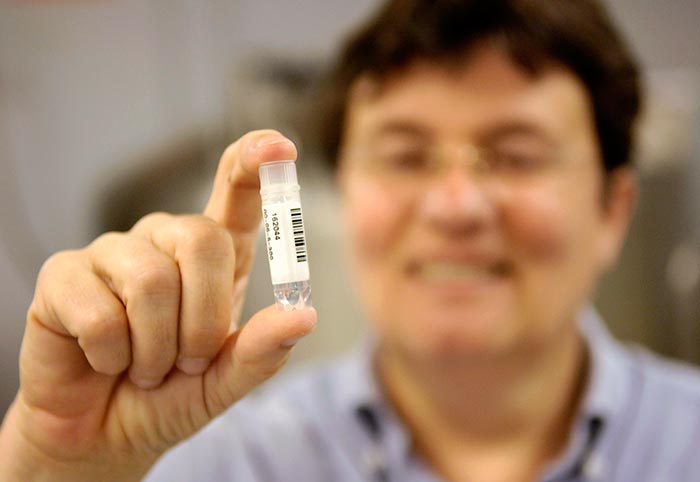New York City—With a quick jerk on the lid, Julie Feinstein opens a humming cryogenic vat. Liquid-nitrogen vapour swirls out over its gleaming lip. “Don’t take a big breath of this,” warns Feinstein. “It’s very cold.” She slips on a pair of stiff rubber gloves, reaches into the vat, and pulls out a frost-encrusted metal rack. Hundreds of vials are tucked inside, each containing a tiny piece of tissue: a butterfly antenna, a frog liver, a slice of whale tail. Feinstein smiles: she’s holding a frozen zoo.
This frozen tissue lab—more formally known as the Ambrose Monell Cryo Collection—is the newest research collection at the American Museum of Natural History. Located in the underbelly of the sprawling institution, the five-year-old facility has an awesome objective: to archive all of the fauna on the planet. “We want it to represent the whole extent of non-human biodiversity, from whales all the way to microbes,” says George Amato, the impassioned director of conservation genetics at the museum and the overseer of the lab. While many of the museum’s other holdings—fish floating in glass jars of formaldehyde, animal specimens in dusty dioramas—have similar objectives, these conventional collections deteriorate after 100 years. Frozen tissue samples, on the other hand, could last thousands—in perfect condition.
As more and more species become extinct, scientists are looking to cryogenics as a way of saving the genetic blueprints of animals. According to the World Conservation Union, human activities such as over-hunting and destroying natural habitat have already pushed two in five species to the brink. Climate change is emerging as another threat—polar bears, for example, will starve or drown as Arctic sea ice melts. “As we get better at identifying the diversity of life on the planet, we also get better at understanding the magnitude of species loss,” says Amato. “We’re losing things much more rapidly than we ever thought.”

Other institutions freeze tissue, but few do it as well and as comprehensively as this museum. Most tissue-storage facilities use mechanical chest freezers, stockpiling samples in Tupperware containers labelled with black ink. But chest freezers sometimes fail, and a melted puddle of genetic resources can be an incalculable loss for scientists.
The museum’s cryogenic storage system is considerably more advanced. But Feinstein, who has been deep-freezing tissue here for three years, insists that it’s a simple operation. “There are vats,” the collection’s laid-back manager says, “and there are computers.” Three of the eight stainless-steel vessels that line the cryostorage room are up and running. Nearly two metres tall and almost as wide, the custom-made vats are insulated like giant Thermoses and drink liquid nitrogen from snaking metal pipes. Temperatures inside the vats are kept below –150°C, cold enough to cryogenically preserve tissue samples in perpetuity. Anything much warmer might desiccate tissue and damage proteins and lipids, changing the molecular structure of the samples and significantly diminishing their research value.
With all eight vats up and running, the lab will eventually accommodate more than half a million vials. (Only the lab’s focus on fauna makes even that remarkable capacity barely adequate to its task; preserving instances of all known fungi, for example, would require several times as much space.) Just 15,000 samples have been deep-frozen so far, but an already impressive variety of species populates the droning vats: amphibians from Madagascar, lizards from Arizona, bats from the Caribbean. Also dolphins and polar bears, cats and coyotes, wasps, fruit flies, endangered honey beetles, and several leech species new to science. Smaller creatures are frozen whole and placed in vials. A snippet of flesh is taken from larger animals; even a single cell contains an organism’s entire genome.
To keep track of the samples and corresponding data such as where and how they were collected (frozen genetic material doesn’t have nearly as much meaning without such information), the lab hijacked grocery-store technology. Scan a bar-coded plastic vial and bleep, information about its contents—a grey wolf donated by the Wildlife Conservation Society, for example—pops onto the computer screen.
Feinstein is giddy over the most recent acquisition: a collection of moths and butterflies from Costa Rica representing almost every known species in the country. The winged insects came via Daniel Janzen, a biology professor at the University of Pennsylvania. “That’s 50,000 moths and butterflies!” Feinstein laughs, undaunted by the tedious task of preparing and freezing such an enormous number of insects. Once she and her curatorial assistants catalogue them, any scientist with an Internet connection will be able to find the insects in the lab’s online database and request samples for research. Today, Feinstein and company are preparing to send three small pieces of frozen frog to a researcher in China.
Archiving the entire range of earth’s fauna is a massive undertaking, but an important one, according to Amato, who says this lab is perhaps the largest frozen-tissue collection in the world. Millions of years of evolutionary history vanish every time a species goes extinct. “By archiving the tissue, we are preserving genetic library books, retaining information even before we know how to read it,” says Amato, his words running together in an excited jumble. Non-human genomes may hold answers to human health quandaries, he says, and as biomedical science hurtles forward, it may soon be possible to recreate individual organisms from frozen genetic material. While cloning isn’t going to solve the current conservation crisis, Amato says, in the future it may yield yet unknown results.
Feinstein thinks of the lab as an ark. In her imagination, the bar-coded vials contain more than frozen cells. Entire animals are preserved inside, protected for the future. But this ark is no wooden boat—it’s a gleaming spacecraft. “In science fiction, there’s a popular setting called a generation ship,” she explains. To escape annihilation, a society dispatches a representative crew on a long journey to a safer world. “But they’re not the people who get there, and they’re not the people who benefit. In the end, it’s the future generations who land on a distant planet, and everything is fine.”


